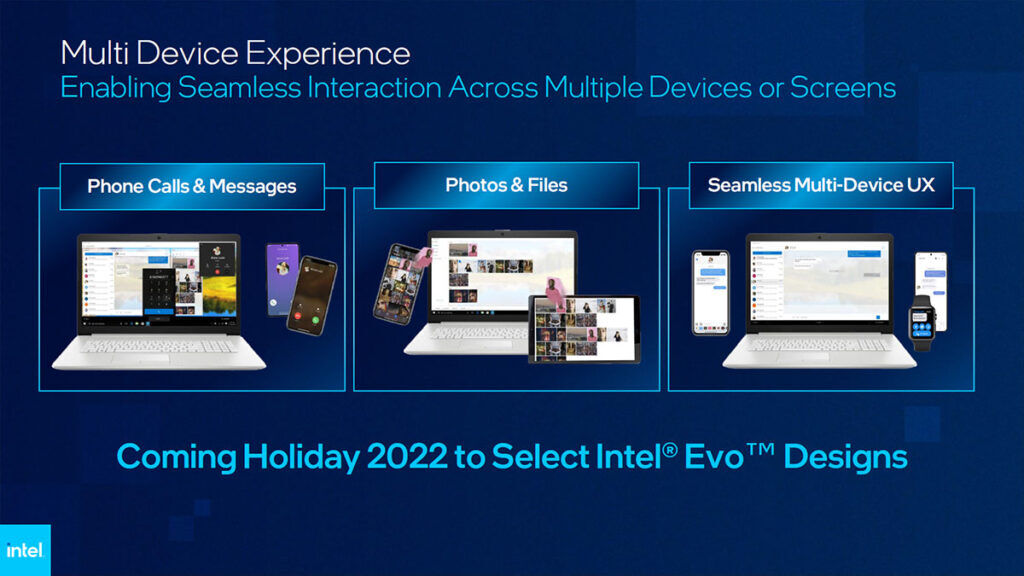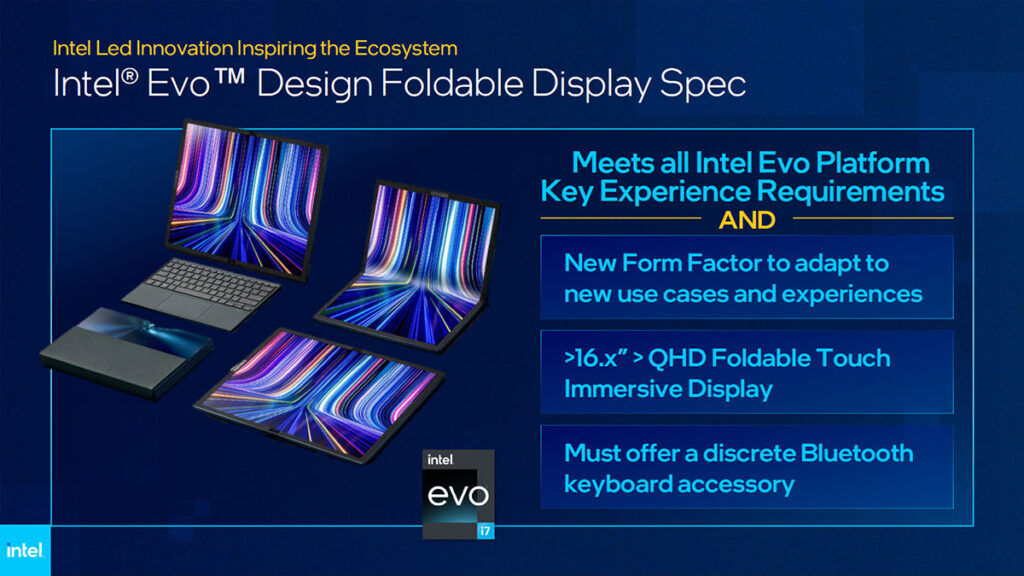12th Gen Intel Core P-series and U-series processors — up to 70% faster than 11th Gen Intel Core
While Intel did share some details about the 12th Gen Intel Core P-series and U-series during CES 2022, the launch back then was mainly focused on the 12th Gen Intel Core H-series processors that are set to power performance-focused gaming and content creator machines. The Intel Core P-series and U-series are targeted towards the ultraportable segment, and while most of the features and performance benefits are similar, there are a few key differences between these and the 12th Gen Intel Core H-series offerings.
12th Gen Intel Core P-series and U-series: next-gen performance for thin-and-light machines
The 12th Gen Intel Core P-series processors are pretty similar to the 12th Gen Intel Core H-series processors, offering up to 14 cores in a hybrid configuration. It is however rated for a much lower TDP, with a nominal TDP of 28W, or a bit more than half that of the H-series’ 45W nominal TDP. The main difference however would be the lack of the PCIe 4.0 x8 interface for dedicated graphics, as Intel apparently expects OEMs to not pair the 12th Gen Intel Core P-series processors with dedicated graphics.
This is something that’s also shared with the 15W U-series. However this probably won’t stop OEMs from using dedicated graphics, as they can harness a PCIe 4.0 x4 interface for that, out of the two PCIe 4.0 x4 links intended for storage. The PCH does host a total of 12 PCIe 3.0 lanes though, so OEMs can still deliver expandable storage options, if so desired.
The 9W U-series is going to replace the Y-series of yore, with a smaller package, lower power draw, and some I/O options lobbed off to give it half the amount of PCIe 4.0 lanes and Thunderbolt 4 ports. It also loses support for DDR5 and DDR4, instead only supporting LPDDR4X and LPDDR5, which is pretty much what most OEMs will probably go with, considering that efficiency is the main focus of these processors. The PCH also gets some features removed, offering fewer USB ports, no support for SATA and two fewer PCIe 3.0 lanes.
When it comes to performance, Intel also makes some pretty interesting claims with the 12th Gen Intel Core P-series and Intel Core U-series processors outperforming the competition and also the Apple M1 Pro in some applications. Also, remember when we mentioned that Intel doesn’t expect OEMs to use dGPU solutions with these processors? Intel made a few gaming benchmarks with the Intel Iris Xe Graphics delivering rather playable frame rates.
Intel also highlighted their improved image processing unit with the 12th Gen Intel Core processors. While this available across the entire 12th Gen Intel Core mobile processor stack, it’s probably more important here, considering that working professionals are more likely to pick up a laptop powered by the 12th Gen Intel Core P-series and U-series, rather than a gaming machine featuring the H-series processors. The IPU here is apparently much more capable, deliver better noise reduction and overall image quality.
12th Gen Intel Core P-series and U-series Specs
[table]
| Cores / Threads | P-core / E-core Base Clock (GHz) | P-core/ E-core Max Turbo (GHz) | Cache | Graphics | Base Power | Max Turbo Power | Intel vPro | |
| 12th Gen Intel Core P-series | ||||||||
| Intel Core i7-1280P | 14C (6P + 8E) / 20T | 1.8 / 1.3 | 4.8 / 3.6 | 24MB | Intel Iris Xe Graphics, 96EU @ 1.45GHz | 28W | 64W | Enterprise |
| Intel Core i7-1270P | 12C (4P + 8E) / 16T | 2.2 / 1.6 | 4.8 / 3.5 | 18MB | Intel Iris Xe Graphics, 96EU @ 1.4GHz | 28W | 64W | Enterprise |
| Intel Core i7-1260P | 12C (4P + 8E) / 16T | 2.1 / 1.5 | 4.7 / 3.4 | 18MB | Intel Iris Xe Graphics, 96EU @ 1.4GHz | 28W | 64W | Essentials |
| Intel Core i5-1250P | 12C (4P + 8E) / 16T | 1.7 / 1.2 | 4.4 / 3.3 | 12MB | Intel Iris Xe Graphics, 80EU @ 1.4GHz | 28W | 64W | Enterprise |
| Intel Core i5-1240P | 12C (4P + 8E) / 16T | 1.7 / 1.2 | 4.4 / 3.3 | 12MB | Intel Iris Xe Graphics, 80EU @ 1.3GHz | 28W | 64W | Essentials |
| Intel Core i3-1220P | 10C (2P + 8E) / 12T | 1.5 / 1.1 | 4.4 / 3.3 | 12MB | Intel Iris Xe Graphics, 64EU @ 1.1GHz | 28W | 64W | N/A |
| 12th Gen Intel Core U-series (15W) | ||||||||
| Intel Core i7-1265U | 10C (2P + 8E) / 12T | 1.8 / 1.3 | 4.8 / 3.6 | 12MB | Intel Iris Xe Graphics, 96EU @ 1.25GHz | 15W | 55W | Enterprise |
| Intel Core i7-1255U | 10C (2P + 8E) / 12T | 1.7 / 1.2 | 4.7 / 3.5 | 12MB | Intel Iris Xe Graphics, 96EU @ 1.25GHz | 15W | 55W | Essentials |
| Intel Core i5-1245U | 10C (2P + 8E) / 12T | 1.6 / 1.2 | 4.4 / 3.3 | 12MB | Intel Iris Xe Graphics, 80EU @ 1.2GHz | 15W | 55W | Enterprise |
| Intel Core i5-1235U | 10C (2P + 8E) / 12T | 1.3 / 0.9 | 4.4 / 3.3 | 12MB | Intel Iris Xe Graphics, 80EU @ 1.2GHz | 15W | 55W | Essentials |
| Intel Core i3-1215U | 6C (2P + 4E) / 8T | 1.2 / 0.9 | 4.4 / 3.3 | 10MB | Intel UHD Graphics, 64EU @ 1.1GHz | 15W | 55W | N/A |
| Intel Pentium 8505 | 5C (1P + 4E) / 6T | 1.2 / 0.9 | 4.4 / 3.3 | 8MB | Intel UHD Graphics, 48EU @ 1.1GHz | 15W | 55W | N/A |
| Intel Celeron 7305 | 5C (1P + 4E) / 6T | 1.1 / 0.9 | N/A | 8MB | Intel UHD Graphics, 48EU @ 1.1GHz | 15W | 55W | N/A |
| 12th Gen Intel Core U-series (9W) | ||||||||
| Intel Core i7-1260U | 10C (2P + 8E) / 12T | 1.1 / 0.8 | 4.7 / 3.5 | 12MB | Intel Iris Xe Graphics, 96EU @ 0.95GHz | 9W | 29W | Enterprise |
| Intel Core i7-1250U | 10C (2P + 8E) / 12T | 1.1 / 0.8 | 4.7 / 3.5 | 12MB | Intel Iris Xe Graphics, 96EU @ 0.95GHz | 9W | 29W | Essentials |
| Intel Core i5-1240U | 10C (2P + 8E) / 12T | 1.1 / 0.8 | 4.4 / 3.3 | 12MB | Intel Iris Xe Graphics, 80EU @ 0.90GHz | 9W | 29W | Enterprise |
| Intel Core i5-1230U | 10C (2P + 8E) / 12T | 1.0 / 0.7 | 4.4 / 3.3 | 12MB | Intel Iris Xe Graphics, 80EU @ 0.85GHz | 9W | 29W | Essentials |
| Intel Core i3-1210U | 6C (2P + 4E) / 8T | 1.0 / 0.7 | 4.4 / 3.3 | 10MB | Intel Iris Xe Graphics, 64EU @ 0.95GHz | 9W | 29W | N/A |
| Intel Pentium 8500 | 5C (1P + 4E) / 6T | 1.0 / 0.7 | 4.4 / 3.3 | 8MB | Intel UHD Graphics, 48EU @ 0.8GHz | 9W | 29W | N/A |
| Intel Celeron 7300 | 5C (1P + 4E) / 6T | 1.0 / 0.7 | N/A | 8MB | Intel UHD Graphics, 48EU @ 0.8GHz | 9W | 29W | N/A |
[/table]
3rd Edition Intel Evo Specifications
Intel announced the 3rd Edition Intel Evo specifications back at CES 2022, while also announcing that we will be seeing 12th Gen Intel Core H-series processors powering Intel Evo-certified laptops. The key list of features are still pretty much the same, with “intelligent collaboration” leading the front. Intel Visual Sensing Controller will also be making its way to several laptops, giving you better privacy and security by being able to detect when you are stepping away from your laptop, while also enhancing the power saving capabilities of the machine.
Along with that, Intel is also working on delivering “Multi Device Experience” with Intel Evo-certified machines. This seems pretty much like what we have seen from HUAWEI’s Multi-Screen Collaboration or ASUS’ Link to MyASUS, allowing for a more seamless experience transitioning between the multiple devices you own.
Along with Intel Evo-certified laptops we will also be seeing Intel Evo accessories, with an “engineered for Intel Evo” label on them. These are tested to deliver a good user experience when paired with Intel machines, allowing consumers to quickly identify which accessories will give them an easy, hassle-free experience to pair with their laptops.
And last but not least, there will be the Intel Evo Design Foldable Display Spec. The ASUS Zenbook 17 Fold looks set to be the first to carry this certification, although we can probably expect to see other OEMs follow with their Intel Evo-certified foldables soon enough.
Pokdepinion: I was thinking that the 12th Gen Intel Core P-series will give rise to more ultraportable gaming machines, but I guess Intel wants OEMs to only build gaming machines based on the H-series instead.






























